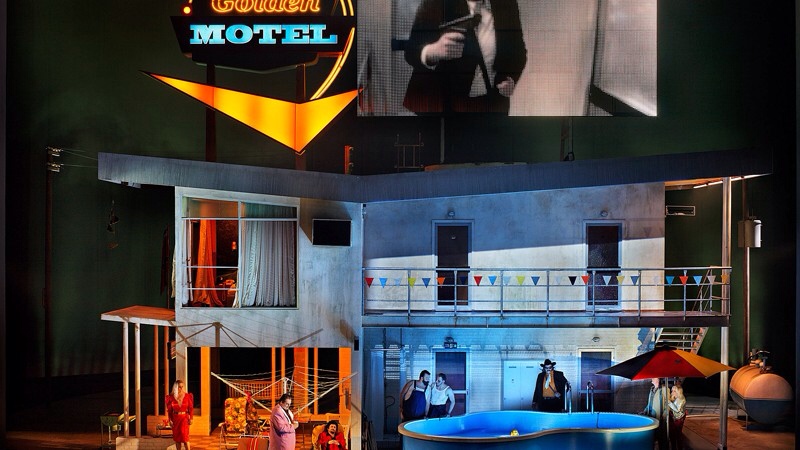There are some productions that “introduce” themselves quite clearly early on: for example, the Patrice Chereau Ring puts it cards on the table very frankly with the image of the hydroelectric dam populated by grisette Rhinedaughters. This is going to be a cycle about the Industrial Revolution and sex. Frank Castorf‘s Rheingold, in its first image or even through its full length, offers no such clear statement of principles.
And that’s curious, because, at least superficially, the opening image shares a lot of similarities with Chereau’s: the Rhinedaughters are in both cases not nixies but real human women, in costumes that at least suggest a definite and specific historical era. (I say “suggest” because the outfits the Rhinedaughters are wearing in this production are sort of odd: too dressy for post-swim coverups or resort wear, too constructed for lingerie, too obviously trashy to qualify for cocktail dresses. There’s a sort of Showgirls feel, perhaps, a trio of Nomi Malones who are off the brown rice and veggie diet.)
The motel they’re lounging about (“cavorting” would be far too strong a word) is hyperrealistic enough that the nonstop video closeups of the action projected on a screen on the building’s roof could pass for cheaply-produced soap opera, and here we run into another aspect of this production that’s not so easy to unpack.
There are apparently some concealed robot-controlled video cameras in various nooks and crannies of the motel set (it contains some interior rooms that are hidden from the audience but can be glimpsed on the video screen), plus some other steadicams are operated by fully-visible cameramen. Sometimes what they are filming is what you would assume is the primary focus of the scene, e.g. Alberich’s belly-flop into the swimming pool to snatch the length of metallic fabric that stands in for the Rhine gold. But other times what we see on the big screen is an “offstage” scene, like Fafner’s menacing the David Cross lookalike who’s the attendant at the gas station attached to the motel. This happens while Fasolt and Wotan are downstage arguing about their contract.
But it’s not as simple as that. The shot keeps cutting away to closeups of Freia, or to what looks like a hidden-camera angle on Loge who hasn’t entered yet, or even from time to time the Rhinedaughters, who, far from disappearing into the depths of the river, continue to inhabit the motel. (When Wotan and Loge go to Nibelheim, here a trailer parked behind the gas station, the Rhinedaughters invade Wotan’s motel room and lounge about in their lingerie, ordering room service and watching television.)
As perhaps you can see by now, there is lot going on in this Rheingold, and yet in no sense is it hyperactive, or, really, most of the time, even active. The affect is sort of desultory, if that’s the right word: nobody gets really angry or really happy. The opening scene of Scene Four, Loge and Wotan taunting Alberich, all three of them, plus Mime, remain lazily sprawled in deck chairs most of the time.
Later, Erda arrives in a sheath of silver sequins and a full-length white fox fur to deliver her ominous warning, but nobody is particularly awed or amazed by her: she just has her say and then slowly, sadly goes her way, looking (to me, at least) like an early 1960s Judy Garland ruefully heading home after a long, uneventful night on the town. (Nadine Weissmann to my mind gave the most successful acting performance in this part, all self-absorbed melancholy: Erda doesn’t really care what happens to the world, but it sure brings her down to have to talk about it.)
Anyway, even after a whole music drama, it’s not at all clear which, if any, way Castorf is heading. Walkuere starts in a couple of hours and maybe after that I can get more of handle on what’s going on with this Ring.
Production photo: Bayreuther Festspiele/Enrico Nawrath







Comments